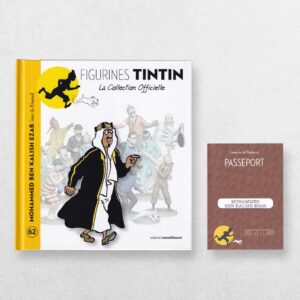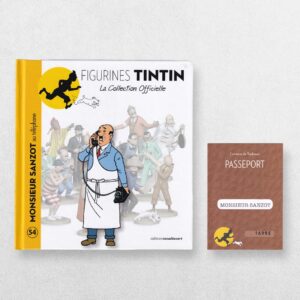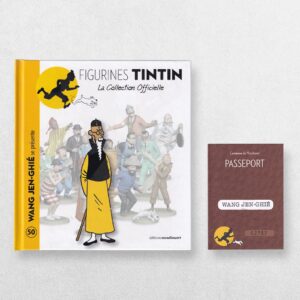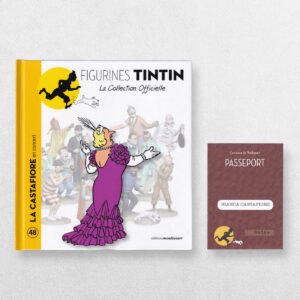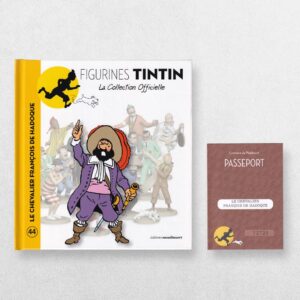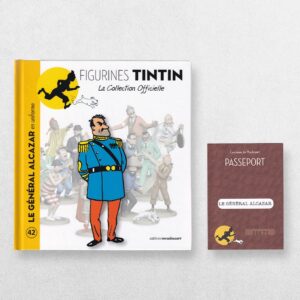Gibbons The Brute – Figurines Tintin La Collection Officielle – 63 – Gibbons La Brute
Hergé & Editions Moulinsart
£55.00
Availability: In stock
Product Description
Gibbons The Brute – Figurines Tintin La Collection Officielle – 63 – Gibbons La Brute
Author: Hergé & Editions Moulinsart
Price: £55.00
Publisher: Editions Moulinsart
Publication date: 2014
Format: Original pictorial boards with passport and figurine
Condition: In near fine condition
Illustrations: Illustrated throughout
Description:
Original pictorial boards. Includes passport loosely inserted. Text in French. Includes the accompanying figurine. One from the collection of 111 books and figurines. Very slight wear. In very near fine, clean condition overall.
Mr Gibbons: A Short Biography
Gibbons appears in The Blue Lotus (Le Lotus Bleu, first serialised 1934–35), one of the most important and artistically mature works of Hergé’s career. Although a relatively minor character, Gibbons serves as a powerful embodiment of Western arrogance and colonial prejudice — a deliberate and uncompromising contrast to Tintin’s integrity and moral courage.
In The Blue Lotus, Hergé cast aside the casual exoticism of his earlier stories and instead produced a narrative rooted in research, empathy, and political awareness. Gibbons’s role within this framework is crucial: he personifies everything Tintin (and, by extension, Hergé) came to reject about Western behaviour in the East.
Character Overview
Gibbons is a British expatriate living in Shanghai during the 1930s, when much of the city was divided into foreign concessions — zones controlled by Western powers where local Chinese inhabitants had little or no rights.
He is depicted as arrogant, idle, and overtly racist: a man who enjoys the privileges of empire while contributing nothing of value to the society in which he lives. His nickname, “the brute”, is well deserved.
Physically, Hergé draws him as broad-shouldered and heavyset, with a florid complexion and an expression of sneering contempt. Dressed in white colonial attire and lounging with a drink in hand, Gibbons represents the self-satisfied European abroad — the kind of character common in the real Shanghai of the 1930s.
Role in The Blue Lotus
Gibbons appears early in the story, during Tintin’s stay in the International Settlement of Shanghai. Tintin witnesses the brutality of Western behaviour towards the Chinese, and Gibbons epitomises this injustice.
When Tintin helps a young Chinese man who has been struck by a European motorist, Gibbons mocks his compassion, referring to the Chinese as “savages” and insisting that Westerners should not bother themselves with “natives.”
This exchange is short but pivotal. Tintin’s furious response to Gibbons marks a moral and artistic turning point in the series — a clear rejection of the casual racism that had coloured Tintin in the Congo only a few years earlier.
In confronting Gibbons, Tintin not only defends the dignity of the Chinese but also asserts a new ethical standard for himself and his creator.
Personality and Traits
- Arrogant: Gibbons exudes a smug sense of superiority based purely on race and nationality.
- Ignorant: He is blind to the culture, history, and humanity of the people around him.
- Cowardly: Like many bullies, his aggression masks insecurity; he sneers from safety and privilege.
- Indolent: He does not work or create; he merely exists as a parasite on the colonial system.
- Hypocritical: He claims to represent civilisation, yet behaves with cruelty and ignorance.
Hergé’s portrayal of Gibbons is intentionally without sympathy — one of the few truly unsympathetic Westerners in The Adventures of Tintin.
Symbolic Meaning
Gibbons’s presence in The Blue Lotus goes far beyond that of a background villain. He carries deep symbolic weight within Hergé’s moral universe.
- Colonial Arrogance:
Gibbons personifies the attitudes of many Westerners in the foreign concessions — those who exploited Asia’s resources and people while insisting on their own cultural superiority. - Moral Corruption of Empire:
His wealth and comfort are built on exploitation. Through him, Hergé shows how colonial privilege breeds moral decay rather than civilisation. - Contrast to Tintin:
Gibbons’s cruelty and prejudice serve to heighten Tintin’s virtue. Tintin, guided by compassion and equality, stands as the antithesis of Western imperial hypocrisy. - Artistic Self-Correction:
Many critics see Gibbons as Hergé’s act of moral redress for Tintin in the Congo. In drawing such an ugly Westerner, Hergé acknowledged and rejected his own earlier naïveté.
Historical and Cultural Context
When The Blue Lotus was written, European powers still maintained semi-colonial control over parts of China, particularly Shanghai and Tientsin. Western residents enjoyed extraterritorial rights, meaning they were subject only to their own laws, not Chinese justice.
This created an atmosphere of arrogance and impunity that Hergé, through the help of his Chinese collaborator Zhang Chongren, came to recognise and condemn.
Zhang’s influence on The Blue Lotus was profound: he educated Hergé about Chinese culture, language, and history, and persuaded him to portray the Chinese people as dignified and intelligent rather than exotic or comic.
Gibbons, then, functions as the embodiment of ignorance — a caricature of those who refused to see the humanity of others.
Artistic Portrayal
In Hergé’s clean-line style, Gibbons’s moral ugliness is expressed through visual economy. His posture is lazy, his features heavy and coarse, his gestures dismissive. The contrast between his self-importance and Tintin’s alert grace creates visual tension.
Even in a single panel, Gibbons exudes vulgarity. His presence disrupts the harmony of the scene — a deliberate artistic reflection of his moral disruption.
Narrative Importance
Although Gibbons appears briefly, his impact on the reader and on Tintin is lasting. His sneering remark crystallises the social injustice that motivates Tintin’s actions throughout the story.
By rescuing and befriending the young Chinese student Chang Chong-Chen, Tintin symbolically undoes the cruelty represented by Gibbons. Their friendship becomes the moral heart of The Blue Lotus, standing in direct opposition to the world of prejudice and power that Gibbons inhabits.
Legacy
Gibbons remains one of Hergé’s most striking moral archetypes — a man without redeeming qualities, designed not to entertain but to provoke moral clarity.
His presence marks The Blue Lotus as the moment when Tintin’s adventures ceased to be simple colonial fantasies and became instead stories of empathy, equality, and justice.
In the broader context of twentieth-century comics, Gibbons’s portrayal is unusually brave. At a time when many European artists still romanticised empire, Hergé dared to show the oppressor as crude and contemptible.
Summary
- Full name: Gibbons (no forename given)
- First and only appearance: The Blue Lotus (1936)
- Occupation: British expatriate and colonial resident in Shanghai
- Traits: Arrogant, racist, idle, cowardly, brutish
- Symbolism: Embodiment of Western colonial arrogance and moral decay
- Opposite: Tintin, whose fairness and compassion expose his hypocrisy
- Narrative role: Catalyst for Tintin’s moral awakening and defence of the Chinese
Conclusion
Gibbons the Brute stands as one of Hergé’s most deliberately unflattering creations — a human caricature of prejudice, ignorance, and moral ugliness. Through him, Hergé delivered a quiet but decisive condemnation of colonial injustice.
Though his time in the story is brief, his shadow looms large. Gibbons’s cruelty makes Tintin’s empathy shine more brightly; his contempt gives Chang’s dignity greater weight.
In the moral geography of The Blue Lotus, Gibbons marks the nadir of human behaviour — a reminder that civilisation is not defined by power or race, but by decency and respect.
Why Buy from Us?
At Hornseys, we are committed to offering items that meet the highest standards of quality and authenticity. Our collection of objects and rare books are carefully curated to ensure each edition is a valuable piece of bibliographical history. Here’s what sets us apart:
- Authenticity and Provenance: Each item is meticulously researched and verified for authenticity and collation.
- Expert Curation: Our selection process focuses on significance, condition, and rarity, resulting in a collection that is both diverse and distinguished.
- Customer Satisfaction: We aim to provide an exceptional customer experience, from detailed descriptions to secure and prompt delivery of your purchase.
- Returns Policy: We offer an unconditional guarantee on every item. If you wish to return an item, it may be sent back to us within fourteen days of receipt. Please notify us in advance if you wish to do so. The item must be returned in the same condition as it was sent for a full refund.
Cataloguer: Daniel Hornsey
Daniel Hornsey has specialised in fine and rare books, ephemera, and collectors’ editions for over thirty years. As a long-standing member of the antiquarian book trade, he has advised private collectors, curated catalogues, and sourced works for leading dealers, libraries and institutions across the world.
Hornseys’ exhibit regularly at book and map fairs in London and throughout the UK and are members of the Provincial Booksellers Fairs Association, the PBFA.
His fascination with Hergé’s work — especially ‘The Adventures of Tintin’ — began in childhood. Daniel recalls reading Tintin in original European editions and quickly recognising that these were not merely children’s books, but finely illustrated narratives crafted with artistic depth and wit.
As noted by the Musée Hergé in Louvain-la-Neuve, Hergé’s ‘ligne claire’ style has influenced generations of European comic artists and his original drawings and paintings command very high prices with his painting of ‘The Blue Lotus’ jar fetching £2.8m at auction in 2021.
By presenting these works through Hornseys’, he hopes to contribute to the continued appreciation of one of the 20th century’s most influential illustrators, helping new generations discover the artistry and legacy of Hergé.
Related products
The Gruffalo & The Gruffalo’s Child: First Deluxe Miniature Editions Both Signed By Julia Donaldson & Axel Scheffler
£495.00Donaldson, Julia & Scheffler, Axel
The Fairies Or The Tales Of Mother Goose Corrected Typescript: Presentation Copy To John Arlott
£275.00Disher, M Willson
You may also like…
Mohammed Ben Kalish Ezab The Emir Of Khemed – Figurines Tintin La Collection Officielle – 62 – Mohammed Ben Kalish Ezab L’Emir Du Khemed
£60.00Hergé & Editions Moulinsart
Thomson as a Syldavian – Figurines Tintin La Collection Officielle – 59 – Dupont Syldave
£80.00Hergé & Editions Moulinsart
Professor Calculus On Skates – Figurines Tintin La Collection Officielle – 57 – Tournesol En Patins
£50.00Hergé & Editions Moulinsart
Mr Cutts The Butcher On The Telephone – Figurines Tintin La Collection Officielle – 54 – Monsieur Sanzot Au Téléphone
£65.00Hergé & Editions Moulinsart
Mr Wang Introduces Himself – Figurines Tintin La Collection Officielle – 50 – Wang Jen-Ghie Se Présente
£60.00Hergé & Editions Moulinsart
Castafiore In Concert – Figurines Tintin La Collection Officielle – 48 – La Castafiore En Concert
£45.00Hergé & Editions Moulinsart
Sir Francis Haddock – Figurines Tintin La Collection Officielle – 44 – Le Chevalier François De Hadoque
£95.00Hergé & Editions Moulinsart
General Alcazar In Uniform – Figurines Tintin La Collection Officielle – 42 – Le Général Alcazar En Uniforme
£45.00Hergé & Editions Moulinsart
Colonel Sponsz Upset – Figurines Tintin La Collection Officielle – 37 – Le Colonel Sponsz Contrarié
£55.00Hergé & Editions Moulinsart
Monsieur Boullu The Stonemason – Figurines Tintin La Collection Officielle – 35 – Monsieur Boullu Le Marbrier
£40.00Hergé & Editions Moulinsart
Haddock Alpinist – Figurines Tintin La Collection Officielle – 34 – Haddock En Alpiniste
£45.00Hergé & Editions Moulinsart
Calculus The Gardener – Figurines Tintin La Collection Officielle – 28 – Tournesol En Jardinier
£35.00Hergé & Editions Moulinsart
Haddock As Hadoque – Figurines Tintin La Collection Officielle – 24 – Haddock En Hadoque
£45.00Hergé & Editions Moulinsart
Ridgewell The Explorer – Figurines Tintin La Collection Officielle – 23 – Ridgewell L’Explorateur
£45.00Hergé & Editions Moulinsart
Tintin In Kilt – Figurines Tintin La Collection Officielle – 22 – Tintin En Kilt
£65.00Hergé & Editions Moulinsart
King Muskar Puts On His Gloves – Figurines Tintin La Collection Officielle – 20 – Le Roi Muskar Enfile Ses Gants
£45.00Hergé & Editions Moulinsart
Snowy Stuck In The Crab Tin – Figurines Tintin La Collection Officielle – 19 – Milou Coincé Dans La Boîte De Crabe
£45.00Hergé & Editions Moulinsart
Nestor With The Tray – Figurines Tintin La Collection Officielle – 18 – Nestor Au Plateau
£45.00Hergé & Editions Moulinsart
Chang Points Out Hou Kou – Figurines Tintin La Collection Officielle – 8 – Tchang Indique Hou Kou
£35.00Hergé & Editions Moulinsart
Tintin In A Lunar Spacesuit – Figurines Tintin La Collection Officielle – 7 – Tintin En Scaphandre Lunaire
£55.00Hergé & Editions Moulinsart
Snowy Carries His Bone – Figurines Tintin La Collection Officielle – 6 – Milou Promène Son Os
£40.00Hergé & Editions Moulinsart
Castafiore With The Parrot – Figurines Tintin La Collection Officielle – 5 – La Castafiore Au Perroquet
£75.00Hergé & Editions Moulinsart
Thomson Looking Awkward – Figurines Tintin La Collection Officielle – 4 – Dupond Engoncé
£40.00Hergé & Editions Moulinsart
Professor Calculus With A Spade – Figurines Tintin La Collection Officielle – 3 – Tournesol A La Bêche
£40.00Hergé & Editions Moulinsart
Haddock Doubtful – Figurines Tintin La Collection Officielle – 2 – Haddock Dubitatif
£40.00Hergé & Editions Moulinsart
Tintin In Trenchcoat – Figurines Tintin La Collection Officielle – 1 – Tintin En Trench-Coat
£75.00Hergé & Editions Moulinsart







